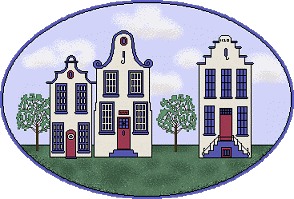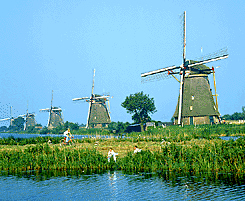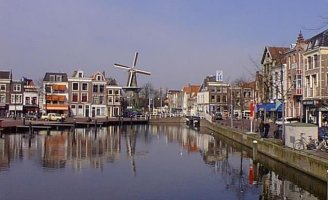


Kinderdijk:
The village my husband grew up:
At Kinderdijk in The Netherlands province of South Holland, you
will find nineteen windmills lined up. Although there are lots
of windmills in the Netherlands, you will not find this much mills
together at one spot as in Kinderdijk!
As you probably know, much of The Netherlands is below sea level
and the farms and towns are protected by dikes. These windmills
were built to pump water out and keep the farms and towns dry.
At Kinderdijk, the mills from 1740 still run!
There are many, many windmills in the Netherlands. Most of them
are in very reasonable, many of them even in excellent, condition
and a lot of them are working regularly.
There are windmills of the most varied types: drainage mills,
corn mills, and industrial mills for all sorts of purposes.


Leiden:
The city I was born and raised.
Very beautiful city and I am still very proud of it, though I
do not live there anymore.
I have tried to gather some info and links.
Click here.




School:
Children from 4-12 years old go to elementary school. Most schools start at 8.30 and have lunchbreak at 12.00 (
Wednesdays at 12.30), children mostly eat at home and then go to school again from 1.15 until 3.15.
On Wednesday they only go to school in the morning.
In the Netherlands we do not know such a thing as homeschooling.
Children are obliged by law to attend school when they are five
years old, almost all children start primary school at four (i.e.
the first year is optional).
Primary education is free of charge. School books are supplied
by the school.
Most primary schools are divided into eight classes, each containing
one age-group. The same teacher is responsible for teaching a
class all subjects during a school year.
The school year runs from 1 August to 31 July. The date for the
six-week summer holiday and its duration are laid down by government
authorities. They are staggered over the three large regions into
which the country is divided for this purpose.




the Weather:
We have cool summers and mild winters.
The last time we had snow on both Christmas days was in 1981!
The temperature does not fluctuate greatly in the course of a
day or a year. The average temperature fluctuates between 2 °C
in January and 17 °C in July.
About 800 millimeters of rain fall each year.



Food:
I must say that I am not particularly fond of Dutch food, but many dutchmen cannot live without
the potatoes/vegetables/meat for dinner!
Typical Dutch things I do like are: cheese and drop (black salt liquorice).
recipes




Tulip time:
Most famous of course is 'the Keukenhof', Holland's famous bulb
flower park.
Generally speaking the bulb flowers bloom from the end of March
to the end of May. But the exact period depends on the weather
conditions, of course. The tulips are usually at their most beautiful
in the second half of April.
The Keukenhof is the biggest bulb show on earth. A tongue-twister
for non-native Dutch speakers, the Keukenhof owes its name to
Countess Jacoba van Beieren, who owned the grounds in the 15th
century. Though the herbs and vegetables in her "kitchen
garden" have made way for an array of more colorful flowers,
the name has never been changed.
Keukenhof: Some 70 acres of winding paths,
gurling streams, gushing fountains, placed ponds and more flowers
than you have ever seen in one place at one tine. Almost 7 million
at last count. Tulips, daffodils, hyacinths and other flowering
bulbs, flowering shrubs, ancient trees, and countless natural
surprises. With ten ever-changing indoor exhibitions or flower
parades, seven theme gardens, a corn mill and a special route
for children.
Keukenhof



Clogs or Wooden Shoes:
The wooden shoe has already been worn in the Netherlands since
the end of the Middle Ages. Because of the wetness of the ground
and the abundance of trees in the Netherlands it was an easy choice
to make clogs. The clogs were then handmade by the users themselves.
They used the wood of willows or poplars. Many parts of the country
had their own clogs, with its own characteristics. Different painting
and woodcarving were used as decorations. There were special painted
clogs for Sundays and festivities, special clogs for bridal days.
Nowadays clogs are being made with machines in clogfactories.
Are clogs safe?
The Netherlands Organization for Applied Scientific Research was
called forward to run a battery of tests on the wooden shoe.
The tests of the research were:
* Cold test: Falling of the temperature in the clog is not allowed
to be more than 10º C when the clog has been exposed of extreme
coldness of - 20º C during 30 minutes.
* Warmth test: The rise in temperature in the clog may not be
more than 21º C when the clog has been exposed of extreme
warmth of 150º C during 30 minutes.
* Nail test: The clog endured the pressure of a nail under the
clog with 75 kg.
* Water test: The clog endured the test of the absorption of water.
* Pressure test: The clog endured the test of pressure of 400
kg on the instep to 750 kg on the nose of the clog.
* Fall test: The clog endured the fall of a blunt axe of 20 kg
from the height of 50 cm.
The result:
Our wooden shoe matched or outperformed modern-day, steel-toe
factory boots in every test!!
Links:
Wooden Shoes Holland Site
History of the Wooden Shoe

Our Struggle against the water:
Holland used to be, and still is, inextricably bound up
with water. This country, located on the North Sea, came into
being in prehistoric times as a delta of the rivers Rhine, Meuse
and Scheldt. The ever-changing water level of these rivers, the
wind, the ebb and the flood resulted in a landscape with very
deep estuaries and an irregular coastline. Time and time again
the dunes and man-made dikes proved not to be equal to the forces
of nature. During the great flood of 1953 the dikes burst in dozens
of places. The consequences were disastrous: over 1,800 people
died, thousands of cattle drowned and the financial losses were
enormous. 1958 Saw the start of the Delta project. Central to
this gigantic project is the closure of all estuaries in the south-western
part of Holland, with the exception of the New Waterway and the
Wester Scheldt (both open waterways to the sea). On top of this
all the dikes had to be reinforced and raised. The safety of the
whole of Holland was thus guaranteed.



St. Nicholas (Sinterklaas):
Long before 6 December it occupies everyone's thoughts.
The Dutch prepare full-on for St Nicholas' birthday. In November
the steamship carrying St Nicholas and his Black Peters to Holland
arrives, and is met by thousands of people. His entry is also
broadcast live on television. Shop-windows are decorated with
special sweets and presents. Children who believe in the existence
of St Nicholas put their shoes under the stove before they go
to bed, they make rhymes, and sing songs.
St Nicholas is a renowned national saint about whom there is no
reliable history information. He is thought to have been Bishop
of Myra (Turkey) in the fourth century. Nicholas is the patron
saint of students, children, cities and countries. Since the 9th
century Nicholas has been worshipped in Italy. In the legends
which circulated about him in Holland Spain replaced Italy. That
explains his Moorish servant Black Peter. Nowhere in the world
is the birthday of St Nicholas celebrated as extensively as it
is in Holland, by everyone, young or old. It is celebrated on
5 December, the eve of his actual birthday. Originally a feast
for children, it has gradually become an occasion for the whole
family, who exchange gifts which are usually accompanied by rhymes
which take the mickey out of the recipient. Sometimes the presents
are wrapped up elaborately, making the unwrapping quite an adventure.
Traditional sweets are eaten, including ginger-bread men and spiced
biscuits.
Other public holidays in the Netherlands: New Year's Eve, Good
Friday, Easter Sunday and Easter Monday, Liberation Day (5 May),
Ascension Day, Whitsuntide, Christmas Day (25 December) and Boxing
Day (26 December).
Links:
Sinterklaas info
More info on Sinterklaas


Other sites with lots of info:
Learn Dutch!!
The Royal Netherlands Embassy
Dutch Export Site

Museums:
Museums
Anne Frank house
Amsterdam Historical Museum

Attraction Parks, Zoo's etc.:
Artis Amsterdam Zoo
Burgers' Zoo, ArnhemDutch only
Dolphin Attraction Park
De Efteling Attraction Park
De Hoge VeluweNational Park
Adventure park Hellendoorn

 June 2006
June 2006

Back to:
Monica's page
index
HOME



|
|
|